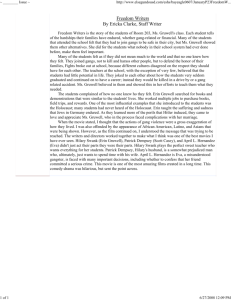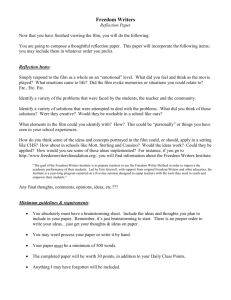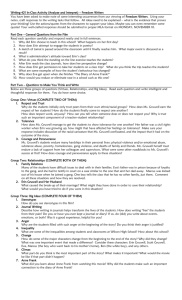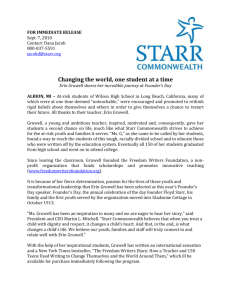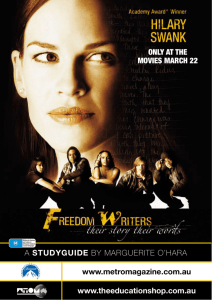The Freedom Writers
advertisement
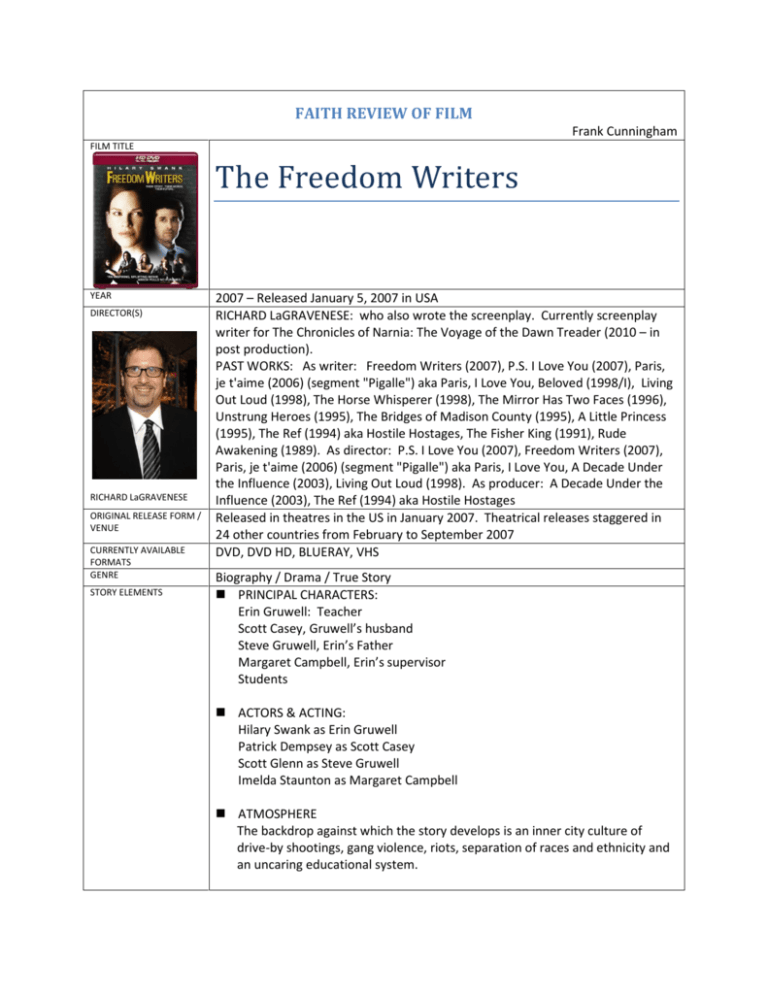
FAITH REVIEW OF FILM Frank Cunningham FILM TITLE The Freedom Writers YEAR DIRECTOR(S) RICHARD LaGRAVENESE ORIGINAL RELEASE FORM / VENUE CURRENTLY AVAILABLE FORMATS GENRE STORY ELEMENTS 2007 – Released January 5, 2007 in USA RICHARD LaGRAVENESE: who also wrote the screenplay. Currently screenplay writer for The Chronicles of Narnia: The Voyage of the Dawn Treader (2010 – in post production). PAST WORKS: As writer: Freedom Writers (2007), P.S. I Love You (2007), Paris, je t'aime (2006) (segment "Pigalle") aka Paris, I Love You, Beloved (1998/I), Living Out Loud (1998), The Horse Whisperer (1998), The Mirror Has Two Faces (1996), Unstrung Heroes (1995), The Bridges of Madison County (1995), A Little Princess (1995), The Ref (1994) aka Hostile Hostages, The Fisher King (1991), Rude Awakening (1989). As director: P.S. I Love You (2007), Freedom Writers (2007), Paris, je t'aime (2006) (segment "Pigalle") aka Paris, I Love You, A Decade Under the Influence (2003), Living Out Loud (1998). As producer: A Decade Under the Influence (2003), The Ref (1994) aka Hostile Hostages Released in theatres in the US in January 2007. Theatrical releases staggered in 24 other countries from February to September 2007 DVD, DVD HD, BLUERAY, VHS Biography / Drama / True Story PRINCIPAL CHARACTERS: Erin Gruwell: Teacher Scott Casey, Gruwell’s husband Steve Gruwell, Erin’s Father Margaret Campbell, Erin’s supervisor Students ACTORS & ACTING: Hilary Swank as Erin Gruwell Patrick Dempsey as Scott Casey Scott Glenn as Steve Gruwell Imelda Staunton as Margaret Campbell ATMOSPHERE The backdrop against which the story develops is an inner city culture of drive-by shootings, gang violence, riots, separation of races and ethnicity and an uncaring educational system. POINT OF VIEW The point of view is from the perspective of the new teacher, Erin Gruwell, who finds herself in a school having issues of racism and violence. While her point of view carries through the movie, there are interlaced diversions to points of view of her students. These shifts are effortless and purposeful. They allow the viewers glimpses into the world of each of the students. PLOT Based on a true story, Swank as Erin Gruwell begins her teaching career as a freshman English teacher in Woodrow Wilson High School in Long Beach, California. The school is voluntarily integrated, and it isn't working. The Asians, the Blacks, the Latinos, and a very few whites not only don't get along, but also stay with their own and are part of protective and violent gangs. There isn't much teaching or learning going on at the school. It is a warehouse for young teenagers until they can drop out or are kicked out. Gruwell enters as a new teacher having a middle class, well educated idealist background. She quickly realizes that the school system is uncaring and has given up on these teens as “unteachable.” Gruwell battles the uncaring system, a husband who is jealous of her time commitments, and a father who expresses his disappointment in her career choice. Gruwell brings not just education but a new sense of hope to her students as well as a new found purpose to their lives. PACING Intentionally, the pacing of the film varies. The normally slower pacing is accented with a fast pace during the scenes of violence and conflict. FILM LANGUAGE ELEMENTS CENTRAL THEMES Discrimination, racism, intolerance moves to finding commonality, rising above the issues, and commitment of and to change. SETTING A contemporary setting in a high school and in the community of Long Beach, California STAGING Take note of the lack of integration. Just like in the community, each race divides itself off from other groups and races. This is noted on school grounds and in the classroom where students move their desks and select seat locations based on race. CAMERA SHOTS AND ANGLES Camera angles are key to the telling of the story in terms of the communication going on between the teacher and students. The shots of the teacher are from the position of the sitting student and the student shots are from the point of view of the standing teacher. EDITING The movie was edited into a tight moving story. Some of the deleted scenes are included in the DVD under the “Deleted Scenes” icon. Two deleted scenes that would be a good opener for discussions are the class attending a showing of the movie “Schindler’s List” and the follow on scene of having dinner together in an upscale restaurant. MUSIC An attention grabber at the beginning and ending of the movie is a hip-hop song written and recorded for the movie. The songwriters used a strong hiphop beat with the intermix of segments of Martin Luther King’s “I Have A Dream” speech. Throughout the movie street music is used in transitioning between scenes and themes. AUDIENCE / CULTURAL CONTEXT ELEMENTS INTENDED VIEWERS This is a movie that is intended to inform. It reaches out to those most like the students, telling them that there is a way out. It reaches educators and education administrators with insights about the condition of and one answer to giving up on students. And it reaches parents and students and communities without the level and extent of hardships faced by these inner city students. It teaches that one person can make a difference. ATTITUDE TOWARDS AUDIENCE The film believes that everyone watching can relate to it. An important message is being shared even though it will have variations of meaning depending upon the background of the audience members watching. SOCIAL, ECONOMIC, PSYCHOLOGICAL CONTEXT This is the element that drives the film. Contrasting “haves” from those who are the “have nots” of society, we are given the chance to look at ourselves and the groups we have isolated ourselves within. The level of violence experienced by these children was never realized in where and how I live. But the degree of indifference and the degree of giving up on a class of people runs rampant here and everywhere just as much as it did in Long Beach, California. THEOLOGY IS FOUND RELATIONSHIP OF FILM TO CULTURE The film captures a broken segment of our culture that is not pretty. While these inner city students faced violence and other real concerns of safety, they also faced an education system that dedicated little if any resources or caring. These were students without hope. While issues of violence may not be equated, there still remain segments of our population who are without hope. This film helps us to see those segments closest to us. Theology is found indirectly in and outside of this film. Theology of the highest commandment of loving others as yourself is modeled by teacher Gruwell. In very broad and general terms, the film opens up questions about human being, community and sinfulness. Outside of the film, discussion can focus on the nature of the groups and communities found in the film and how they might be related THEOLOGICAL THEMES FOR CONVERSATION theologically to the groups and communities of which we are a part. Hope: How does God instill hope in each of us? Where have we seen division and isolation resulting in people being treated differently? Do you know someone who has lost hope? As God’s people, how are we to respond to others whose hope is lost? Is there a difference in your mind between knowing what you are supposed to do and what you are willing to do? Why? Love: What does it mean to have agape love? How does that form of love fit in with “The Freedom Writers?” Do we turn away from others? How? What would Christ say of that? Church: Why is it that most churches today are segregated? Are these examples of the same groups we see in the movie? Like the students who moved their desks around, have we built barriers around us? Living into the life of Christ, how should we respond? Broken Human Condition: In the discussion phase, list all of the brokenness found in the film. Note who is broken and how are they broken. Christ: Can one make a difference? What elements do we see that might cause us to consider Gruwell a Christ figure? SUGGESTED TYPE OF CONVERSATION I see the film as a critical challenge in some respects and for deepening of the theological themes in other respects. RECOMMENDED WAYS TO VIEW AND ENGAGE THE FILM View the film in its totality, watching it together and converse immediately thereafter. CONCLUDING OR SUMMARY REMARKS The security guard breaking up the first fight in the classroom is the actual Freedom Writer who was the subject of the vulgar cartoon passed around in class. The young man playing the video game machine in the convenience store was killed just weeks after the movie was shot. A gang member wanted his skateboard chain and shot him when he refused to give it to him. Rated PG-13: some vulgar language, violence including drive-by shooting, riot video, school fight, and domestic violence scene. www.freedomwritersfoundation.org REVIEW COMPLETED BY Frank Cunningham – February 15, 2010

